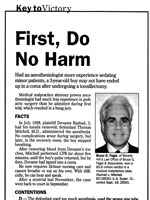Published in: Daily Journal
Friday, October 20, 2000
Key to Victory
First, Do No Harm
Had an anesthesiologist more experience sedating minor patients, a 3-year-old boy may not have ended up in a coma after undergoing a tonsillectomy.
By Eron Ben-Yehuda
Medical malpractice attorney proves anesthesiologist had much less experience in pediatric surgery than he admitted during first trial, which resulted in a hung jury. Bruce G. Fagel, of Beverly Hill’s Law Office of Bruce G. Fagel & Associates, won a $5.6 million verdict in a medical malpractice case, Rashad v. Mitchell, BC198261 (L.A. Super. Ct., verdict Sept. 19, 2000).
FACTS
In July 1998, plaintiff Devante Rashad, 3, had his tonsils removed; defendant Thomas Mitchell, M.D., administered the anesthesia. No complications arose during surgery, but later, in the recovery room, the boy stopped breathing. After removing blood from Devante’s trachea, Mitchell performed CPR for about five minutes, until the boy’s pulse returned, but by then, Devante had lapsed into a coma.
He now requires 24-hour nursing care and cannot breathe or eat on his own. With difficulty, he can hear and speak. After a mistrial last November, the case went back to court in September.
CONTENTIONS
P – The defendant used too much anesthesia, used the wrong size tube in the trachea and took too long to respond when the oxygen monitor showed the child was having trouble breathing.
D – He constantly observed the child. As soon as the oxygen monitor signaled dangerously low breathing, he immediately came to the rescue. All care during the resuscitation was appropriate, but the boy slipped very quickly into cardiac arrest. The outcome was an unfortunate complication of surgery.
OVERALL APPROACH
In essence, the case was a battle of the experts, attorney Bruce G. Fagel says. The danger is confusing the jury by giving overly technical explanations for what went wrong, he says. Fagel avoided that trap by hiring as his main expert the chief of pediatric anesthesia at Stanford Medical Center in Palo Alto, who explained in the simplest terms how the defendant had made a mistake.
According to Fagel, this expert’s down-to-earth approach successfully countered the defense’s attempt to distract the jury by having its main expert give what he considered irrelevant examples of other clinical situations in which this type of injury could occur.
The defense attorney also attempted to challenge another of the plaintiff’s experts by arguing that he was unqualified because his work focused primarily on anesthesiology for adult patients, whereas the plaintiff was a child, Fagel says. But with the expert on the stand, Fagel used opposing counsel’s own evidence to undermine the defense’s claim.
“Since the defense had used several pediatric anesthesia texts during the trial, I picked up one of the texts off the defense attorney’s desk and asked my expert, ‘Who wrote the chapter on pediatric resuscitation ?'” “The expert responded, ‘I did,’ and the jury laughed,” he says.
TURNING POINT
The case hinged on Mitchell’s experience treating children undergoing tonsillectomy surgery, Fagel says. In the first trial, the doctor claimed he had worked on about 25 cases. But Fagel obtained a court order before the second trial forcing the hospital to review its records, which showed that Mitchell was the anesthesiologist for only five pediatric cases, none of which were tonsillectomies, he says.
TIPS FOR WINNING
Make the issues as simple as possible for the jury, Fagel says. In the first trial, Fagel tried to prove that the surgeon, the nurses as well as the anesthesiologist were to blame. As a result, the jury had to sift through three sets of defense experts in addition to scores of witnesses.
“If the jury is confused, then the plaintiff cannot meet his burden of proof,” he says.


